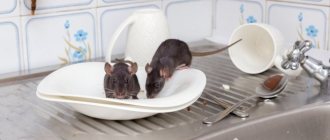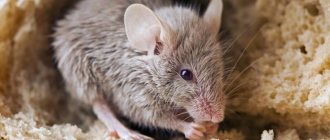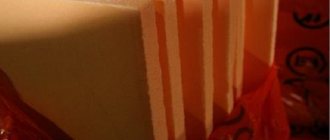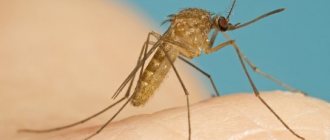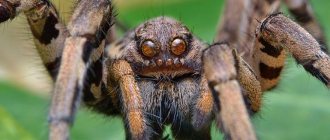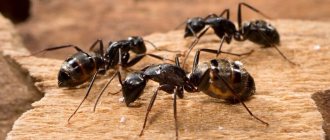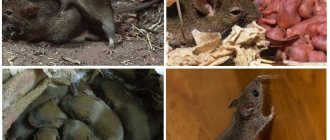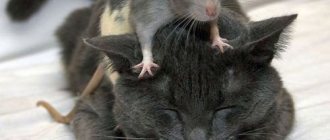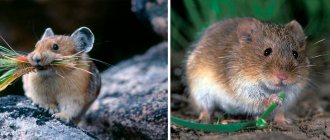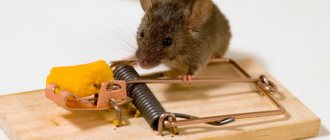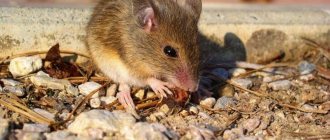What does it look like
These rodents are quite small in size - the length of the largest individual is approximately 14-15 cm, and the size of the small mice is 7 cm.
This representative is distinguished by an elongated and pointed muzzle, round eyes and large ears.
The tail of the mammal is hairless, with small fluff and ring-shaped scales. The length of the tail is almost equal to the size of the animal’s body. The fur is short and quite smooth.
The color of the animal depends on its habitat: mice that live in deserts are sandy or brown, rodents that live in the north are usually grayish or black.
The hind legs with clawed toes are longer than the front ones: there are four in front and 5 in the back.
Types of bats (blood-sucking)
Observing representatives of the order Chiroptera, we found out that in the wild the bat eats not only insects and plants. Among these animals there are also those that feed on blood.
Common Vampire
A very numerous species has spread the opinion of bats as vampires, capable of drinking all the blood from an animal or a person. Another name is big bloodsucker. The enzyme contained in the saliva of these animals can be quite dangerous: it affects blood clotting. Even a minor wound can cause major blood loss. And if several dozen bloodsuckers attack during the night, then death is inevitable.
This not very large bat (weight no more than 50 grams, and a wingspan of up to 20 cm) spends the entire day sleeping upside down in its shelter in the large company of its fellows, and at nightfall it flies out to hunt. She chooses her prey among sleeping animals, especially prefers cattle - they cannot resist. Choosing a place on the body near the blood vessels, the animal bites and licks the blood, which easily flows out of the wound.
A person can also be attacked by ordinary vampires if he spends the night in places accessible to these bats.
The habitat of this species is South and Central America.
White-winged vampire
A representative of this species has average dimensions for chiropterans: body length is up to 11 cm, weight is up to 40 grams, and the wingspan is up to 40 cm.
Like the common vampire, the white-winged one lives in South and Central America. Its fur has a reddish-brown tint, somewhat lighter on the belly.
The white-winged vampire attacks birds; it is their blood that is the animal’s diet.
Hairy Vampire
It lives in the same places as its brothers that feed on blood. But representatives of this species can easily attack both birds and animals.
Unlike other bats, the bushy-footed vampire does not have well-developed hearing, so in its flights it relies not so much on the usual echolocation as on vision.
Their grayish-brown color and small size allow them to approach their victims unnoticed.
Many researchers have noted that hairy-legged vampires are absolutely not afraid of people: they can fly very close, practically sitting on their hands.
Bats are often frightened by being called blood-sucking and dangerous, but out of all the variety of species, only three actually drink blood.
Backbone
The skeleton of the animal, although light, is very strong, elastic and mobile.
Mice have a skull and part of the muzzle that are slightly elongated; places of fusion of bones appear on the skull. The most prominent bones are the parietal, lamboid, interparietal, parietotemporal, coronoid, and frontal.
In this article you can see what small mice look like.
The lower jaw of the animals is developed and can move in different directions.
The spine of rodents consists of 5 parts, in particular:
- 7 cervical vertebrae;
- 13 thoracic vertebrae;
- 7 lumbar;
- 4 sacral;
- 20 tail.
The brisket is quite narrow in size - it has 13 paired ribs.
What benefits do bats bring?
In nature, bats do more good than harm. There are only a few blood-sucking species, so it is impossible to say that it is chiropterans that transmit diseases.
But they destroy insects that, flying from one animal to another, are capable of spreading infections. During the season, animals eat a huge number of mosquitoes, beetles and butterflies, many of which, for example, in tropical countries, actually carry fatal diseases.
They protect chiropteran gardens and agricultural lands from pests that can destroy crops or harm trees and shrubs.
By flying from plant to plant, they help pollinate them.
Bat droppings are an excellent fertilizer. In some caves where animal colonies live, up to a meter of excrement can accumulate.
Enzymes from bat saliva are used in medicine.
Dental system
These mammals have two pairs of well-developed incisors on each jaw. They don't even have roots in front and grow throughout their lives. The upper ones are larger in size than those located below, they are protected by strong enamel.
The mouse fangs on the jaw are replaced by a toothless edge - a diastema; behind it are molars, some of them smooth, others lumpy. Thanks to them, parasites grind food. Molars are constantly growing and need to be ground down.
If an animal wants to gnaw on an iron or hard object, they are able to break off the lower incisors from below, this risks the fact that the teeth on the upper jaw will bend inward, thus the mammal will not close its mouth without having eaten.
- Body structure
- Behavior of mice in the natural environment
2
Biological features of the mouse
The structure of the mouse body has features characteristic of all representatives of the rodent order. The main distinguishing feature is the structure of the dental system.
Body structure
Mice belong to the class of mammals, the order of rodents, the suborder of mouse-like animals, and the family of mice (Muridae)
and the mouse subfamily
(Murinae)
. It also includes rats, since mice are very similar in appearance to them.
Rodents (Rodentia)
are the most numerous order of the class of mammals, uniting more than a third of all their species.
Rodents are distributed throughout the globe. Currently, they are divided into approximately 30 families, including more than 400 genera. Numerous species of rodents are divided into three suborders: squirrel-like (Sciuromorpha)
are divided into 5 modern families (beavers, American mountain beavers, squirrels, bag rats, heteromyids) and 5 extinct ones;
porcupines (Hystricomorpha)
are represented by 12 modern families (true porcupines, arboreal porcupines, guinea pigs, capybaras, agouti, nutria, chinchillas, etc.) and 3 extinct ones;
mouse-like (Muomorpha)
unites 10 modern families (dormouse, selevinia, mice, jerboas, mole rats, mice, hamsters, etc.) and 3 extinct ones.
The mouse-like suborder includes the largest number of species, whose representatives inhabit all natural zones, from the Arctic tundra to the snow line in the mountains. Most rodents live in burrows, but feed on the surface. There are also forms that lead a predominantly terrestrial lifestyle (mice, rats), completely underground (zokor, mole vole), semi-aquatic (beaver, muskrat) and arboreal (squirrel, dormouse).
The structure of the limbs of rodents is adapted for digging, swimming, running on the hind limbs (jerboas), climbing, and even gliding flight (flying squirrels). Rodents tolerate adverse environmental influences better than other mammals, are capable of rapid reproduction and reach the highest numbers within the class .
Fossil remains of rodents date back to the Paleocene. Scientists suggest that this order of mammals arose in the Cretaceous period, possibly from common ancestors with insectivores.
The mouse is a small animal with a sharp, elongated muzzle and large eyes and ears. The bare tail, covered with very sparse hairs, reaches a length equal to half the animal’s body. Ring scales are clearly visible on it.
The mouse skeleton is light, but quite strong, characterized by high mobility and elasticity.
The mouse spine consists of five sections: cervical, thoracic, lumbar, sacral and caudal. The cervical region consists of 7 flattened vertebrae, forming a short, tightly articulated column. There are 13 thoracic vertebrae, 6 or 7 lumbar vertebrae. The lumbar region consists of two true and two false lumbar vertebrae, which fuse to form the sacrum. There are up to 20 vertebrae in the caudal region.
The chest is narrowed laterally. From above it is formed by the thoracic vertebrae, to which 13 pairs of ribs are adjacent, and from below there is the sternum, protruding into the abdominal cavity. The chest reliably protects the internal organs of the animal.
The hind limbs are longer than the front limbs, each with five toes. The forelimbs are four-toed, the first digit is reduced. Mice have claws at the ends of their fingers.
In mice, as in other rodents, the right and left halves of the pelvis are separated, and there is no pubic fusion. In young females, the pubic bones are tightly connected by ligaments, but in females that have given birth, the ends of the bones diverge. This structure of the pelvis contributes to a painless birth. A mouse usually gives birth to a large number of fairly large babies.
The mouse skull is elongated, with eye sockets, and the facial part is elongated. For adult individuals, the development of ridges (joints of the skull bones) is typical - coronoid, frontal, sagittal, parietotemporal, lamboid. The frontal and lamboid crests are especially pronounced. The paired frontal bones, together with the paired parietal and unpaired interparietal bones, form the roof of the skull. The unpaired occipital bone limits the brain cavity posteriorly and has a foramen magnum. The cervical vertebrae are attached to the occipital bone. The auditory part of the skull of mice is located on the sides of the posterior half of the braincase and consists of three bones: petrous, mastoid and tympanic. The auditory canal opens in the tympanic bone.
Mice are highly adaptable to changes in environmental conditions. Thanks to this, they are distributed throughout the globe.
The upper jaw is motionless; the upper row of teeth is located on it. The lower jaw consists of two movably connected parts that can move in the transverse direction. The lower jaw itself moves in three directions: transverse, longitudinal and vertical. The lower row of teeth is located on the lower jaw.
The main distinguishing feature of these rodents is the structure of the dental system, which includes two pairs of large chisel-shaped incisors on the lower and upper jaws. The peculiarity of incisors is that they do not have roots, so they constantly grow (up to 1 mm per day). To prevent the incisors from reaching a huge size and taking on an ugly shape, mice grind them down. The front side of the cutter is covered with very durable enamel, the back side wears off faster. Thanks to this, the tips of the incisors are always sharp, which occurs due to uneven grinding. The upper incisors are wider and stronger, and can withstand loads of up to 2.5 kg. The lower incisors are smaller. Between the incisors and molars there is a toothless space (diastema). The molars, whose main function is to grind food, fit tightly together and form a single row. Their surface is different: flat or covered with blunt tubercles.
Structure of the skull and dental system
Molars can also grow. The abrasion of their surfaces should occur evenly; for this, the rodents’ diet should always include additives that they could chew, for example, twigs of deciduous trees.
Table 1
Basic physiological data of the mouse
Mice lack premolar teeth and fangs.
Mice have fairly well developed vision. The eyeball has a spherical shape. There are up to 30 million rods and more than 200 thousand cones in the retina of the eye. The visual acuity of white mice kept at home is weaker than that of their related wild forms. Color vision has been discovered in a number of mouse species. They distinguish between red and yellow, but do not respond to blue and green.
Behavior of mice in the natural environment
Mice have several types of adaptation to unfavorable environmental conditions, either long-term or seasonal. First of all, this is their year-round activity, with the help of which mice make reserves for a possible unfavorable period.
Mice can be active all year round without stockpiling, feeding on food or grain obtained from food warehouses, stores or homes.
Types of adaptation also include seasonal migrations of mice from natural habitats to buildings (late autumn) and vice versa (spring). Mice many centuries ago adapted to living in close proximity to humans.
Mice, like most rodents, have a very difficult time maintaining a normal body temperature due to their small size. Regulation occurs mainly by reducing or increasing the production of internal heat. At low air temperatures, mice produce more heat in their bodies than at high temperatures. Animals may die due to a decrease in vital activity associated with prolonged cooling and the accompanying high consumption of nutrients, the reserves of which are not replenished by the food they eat.
When the air temperature rises, the heat transfer from the body surface decreases, and at the same time the heat release in the body decreases, which also negatively affects the metabolic process.
Body temperature rises to a critical point. If new portions of heat continue to arrive, the animal dies from heatstroke.
Therefore, to maintain normal body temperature, mice expend a lot of energy, which is replenished by eating huge amounts of food.
The activity of life processes, that is, the rate of growth, food consumption and development, directly depends on body temperature. This explains all the physiological characteristics of this animal and its habits, which have developed over many centuries: they are aimed at overcoming the adverse effects of the environment.
The behavior of mice also depends on the seasons of the year. They do not hibernate and store supplies for the winter. If mice live in close proximity to humans and are thereby provided with food, they are mainly engaged in mating games and raise offspring.
Despite their small size, mice can be very brave and courageous. Fighting for survival, they are able to attack animals many times larger than themselves.
Mice activity mainly occurs at night. With the onset of dusk, they begin guarding their area, digging holes and searching for food. Decorative mice living next to a person adapt to the conditions of his life. If mice live in a room with constant darkness, the duration of their activity increases. The animals rest at intervals.
If people are present often and for a long time in the habitats of mice, the animals adapt, as mentioned above, to the human daily routine, that is, they can be seen even during the daytime, especially when the room is quiet.
The circadian rhythms of these animals can change not only due to disturbance associated with human activities. Their daily cycles are also affected by changes in weather and seasons. For example, in the summer, especially in places with a hot climate, mice become active only at night. This saves them from overheating, which is harmful to their body. As the daytime temperature drops, they rearrange their daily rhythms and gradually become active during daylight hours. In this case, periods of wakefulness are interspersed with rest.
The daily distribution of activity is also influenced by the characteristics of the structure of the flock and the position of the animal in the group. Often there is a daily routine in which the periods of wakefulness of the leader of the pack determine the activity of subordinate individuals. At the same time, weak animals prefer to get their own food, explore the territory and dig holes while their leader is resting, so as to, as they say, not catch his eye. The activity of the strongest male often depends on the behavior of his subordinates: the leader becomes more active if they are too noisy.
Factors that influence the rhythm of activity of mice are also the age and sex of the animals. Before the birth of the offspring, the female increases her activity: she has to eat a lot, collect material for building a nest and drive other females away from it. After giving birth, the mouse spends almost all the time in the nest, feeding, warming and caring for the offspring, leaving the shelter only to eat.
In older individuals, activity is reduced compared to the younger generation.
The skeleton of the white-footed (or deer) mouse lacks collarbones. Thanks to this, the animal is able to crawl into very small holes (1 cm in diameter).
For research purposes, humans have learned to control the circadian rhythm of mice and other rodents, directing it to their own benefit. You can make the mice stay awake during the day, when it is more convenient to observe them. To do this, you need to take care of the animals and feed them only during daylight hours.
When meeting, mice sniff each other's faces with extreme caution, and then all other parts of the body. After this identification process, the animals disperse peacefully if the results of this kind of check show that they belong to the same community.
Representatives of the mouse family usually live in large families. A single animal will not be able to quickly detect food, stock up on food for a long winter period, arrange a future home, and notice the impending danger in the form of a predator. In groups it is easier for these animals to survive in natural conditions and raise offspring.
However, living together with mice also has its downsides. Between individuals, as well as in human society, conflicts arise from time to time. They are most often associated with a lack of food, which appears during rapid and excessive reproduction. In order to ensure order in the pack, the subordination of weaker individuals to the stronger ones is maintained. According to this principle, a leader is elected who proves his superiority by certain behavior and specific sound signals.
House mice naturally live in burrows dug by large families. The leader dominates all family members, especially young males. This most likely occurs due to the reluctance to give up one’s “throne” to others. Very often young animals are determined to conquer this place. The signal for the start of war is expressed in tail strikes and stomping of hind legs. If the old leader is defeated in this battle, he becomes a subordinate. There are cases when all young males are in a fighting mood and have an equal chance of success. Then the family breaks up, and its members go in search of females in order to create new families.
Female mice are more peaceful. They often build joint nests, where they hatch and raise offspring together. Males do not particularly care for their cubs, and during the mating season they become aggressive.
Sometimes these animals, upon contact, develop a desire to groom. This involves cleaning the hair from parasites. This, as well as the welcoming ceremony, is of great importance for establishing friendly relations within the family.
To protect themselves from enemies and members of other families, mice demarcate their territory using marks. The animals then use them to navigate. Most often, the marks are odorous, that is, made by urine, feces or gland secretions. Scent signals are also used to convey information about the availability of food, and in females, about readiness to meet a male.
Research scientists have concluded that certain substances in urine even contain information about the genetic makeup of mice. The smell is not the same not only among different mouse-like rodents, but also among neighbors, individuals from other families. If an animal is caught and kept away from its native community for some time, its smell will change or be lost altogether, therefore, when returning, the mouse will be attacked by its former fellow tribesmen.
Like most rodents, mice consume very little water. The amount necessary for life is produced inside the body during the combustion of carbohydrates. Larger mammals and even humans have this ability, but for them the internal source of water is not enough.
Desert species of mice can live without any external sources of water at all. The limited amount of feces and concentrated urine prevent their body from getting rid of valuable fluid. Some desert mice consume small amounts of seawater. An ordinary house mouse can exist without water for a long time.
With the exception of the little mouse, all animals of this family live in burrows. Most of the mice's lives pass in them: here they raise offspring, feed, rest after eating food, make supplies, and hide from unfavorable environmental conditions and danger.
Burrows are divided into temporary and main. Temporary burrows have a simple layout. The main ones consist of many holes connecting to the main nesting chamber and entrance holes. This type of burrow is divided into summer and winter.
Summer burrows are intended for the birth and feeding of offspring, so they are much more complex. They have a nest with soft, warm bedding, which is arranged in advance from bird feathers, wool or dried blades of grass. If mice live in houses near humans, bedding is made from various kinds of leftover household items, that is, from ropes, shavings, paper, rags, etc.
There are species of mice that lead an exclusively arboreal lifestyle. They make nests in the crowns of trees and find food without descending to the surface of the earth.
Before the birth of the offspring, the female expands and cleans the nest.
Winter burrows have a simpler layout than summer burrows. In most cases, they have a chamber for storing supplies - the so-called pantry. Burrows intended for protection from danger and unfavorable environmental conditions or, for example, for rest in hot weather, most often have only one entrance hole and a short side. It has been noticed that young individuals build the smallest burrows for themselves. Most species of mice have several protective burrows.
Such minks do not protect from four-legged predators. Mice hide from dogs, foxes, ferrets and various raccoons in more complex burrows. But even they do not guarantee salvation from the attacks of stoats and weasels, which freely penetrate them.
Minks, in addition to protecting and feeding their offspring, have another equally important function. It consists of providing optimal temperature conditions, since mice have rather weak and imperfect thermoregulation. By taking refuge in a hole, mice save themselves from death due to overheating or hypothermia.
The main feature of shelters is that passages and chambers are located in different layers of soil, so if desired, the animal can choose its optimal microclimate.
Baby mice make spherical nests between tall stems of reeds, reeds and cultivated cereal plants. The nests are thus located at a height of about 150 cm.
Mouse nest
Wood mice live in voids under tree roots or in hollows. Food supplies that allow the mouse family to feed for 1–2 years are stored in underground chambers. In winter, during inclement weather, mice almost never come to the surface of the earth. Also, wood mice that live in fields make burrows with 2–3 entrance holes. A nest is made from split stems. Most often it is located at a depth of 70–80 cm, and from it there is a branch in which food supplies are stored.
House mice live in most cases in warehouses and human homes. If their settlements are in a field, then the animals make burrows, where at a depth of 40 to 50 cm there is an underground nest with several entrance holes leading to it. During the warm season, house mice can change their place of residence several times, settling where there is a lot of food, for example, along the sides of roads, forest plantations, ditches, in gardens and in fields with ripening grain. In the fall, the animals move again, this time into haystacks or forest plantations.
Table of contents
Internal organs
Let's take a closer look at the internal organs. The animal's trachea is located in the cervical region, followed by the esophagus. The thyroid gland is located in the area of the larynx, and a little lower, near the sternum, is the thymus gland. The secretion is released into the blood thanks to these endocrine glands.
The heart valve and lungs are located in the sternum.
Note that a dome-like diaphragm is found only in rodents. It seems to separate the sternum from the peritoneum.
The liver is located under the diaphragm, it is also like a dome. On the left side and slightly below the liver is the stomach, from which the loops of the small intestine branch off.
In the middle of the intestine you can see the lateral outgrowth of the cecum. Note that this organ is quite highly developed in mammals that feed on plant foods. Then comes the large intestine and anus.
In males, testes in the shape of ellipses are located at the bottom of the abdominal cavity. In individuals that have reached puberty, they lie in the scrotum.
Wolffian canals branch off from the testes - ducts into which the ducts of the seminal vesicles flow. Depending on their size, the male will be successful or unsuccessful in breeding. The genital organ is clearly visible.
In female individuals we can see the uterus. In those females who have not yet reached puberty, the uterine horns are very thin, barely noticeable. But for those who have already given birth to offspring, they are wide. The embryo is clearly visible in the uterus of pregnant female mice.
Enemies of bats
Bats do not have many enemies in nature, although the animals are very small in size. This is most likely due to the fact that their nocturnal lifestyle does not give them the opportunity to intersect in nature with many animals that are active during the day. They camouflage their shelters well or live in large colonies, which can be quite scary for many animals and birds to penetrate.
Those bats that fly out to hunt at twilight (for example, noctule bats) more often become prey for daytime birds of prey (hawks, hobbies, peregrine falcons), which happily feed on these bats.
But nocturnal birds of prey (owls and owls) quite often attack bats, although hunting them is very difficult: developed echolocation allows you to notice danger and dodge deadly claws and beaks.
Scientists from one of the American institutes noticed an interesting fact: bats living in the caves of one of the mountain ranges of Hungary are attacked by common tits. Brave birds fly into the caves, grab the sleeping animal and take it to their nest. Birds rarely fly up to colonies, since the number of bats can pose a mortal danger to them.
In those latitudes where many tree snakes live, the bats hiding in the branches have a hard time. During the day, animals, as a rule, sleep in shelters and are not always able to react to an approaching creeping enemy. And they practically cannot fly in sunlight, so they become victims of those snakes who can eat small bats.
Chiropterans, especially small individuals and species, often fall into the clutches of spiders. They cannot see a stretched web in the dark; in this case, echolocation does not always help. But chiropterans can hear an insect beating in a web. Sometimes large spiders that feed on small animals do not specifically kill insect prey in order to catch a larger one - a bat.
Sometimes bats become food for larger predators - weasels, polecats and martens, which sneak up on sleeping animals and kill them.
But the most important enemy is man. Sometimes people destroy entire colonies of bats just because they mistakenly consider them dangerous. Although the animals bring a lot of benefits by destroying insects that carry the infection.
It happens that a person does not intend to kill bats. Some fertilizers or pesticides are harmful to flying animals.
It seems incredible that people also eat bats. In many Asian countries, the meat of these animals is considered a delicacy.
Sense and smell organs
Since these animals lead an active lifestyle at night, their visual organs are poorly developed. As scientists have found, rodents can distinguish between red and yellow colors.
Mice are endowed with excellent hearing - small tailed parasites can even hear high-frequency sounds.
At night or in a dark room, they navigate the area with the help of their antennae - vibrissae. The organ of smell plays an important role in the life of rodents - thanks to the excellent organ of smell, they distinguish friend from foe, find food and determine their location in space.
There are special glands on the paws that secrete a secretion, this substance helps them mark their territory.
When a mouse is frightened or stressed, a special substance appears in its urine; it gives a signal to other relatives about impending danger so that they can run away.
How long do bats live?
An interesting question remains: how many years do bats live in nature? Average life expectancy is 5 years. How long bats live depends on the species. Among these animals there are also long-livers, whose age can reach up to 20 years.
The longest-living record holder among bats is 33 years old.
A bat at home usually lives less than the time allotted to it by nature, since it does not have the opportunity to be fully active.
Features of life
Rodents are active all year round, so they constantly accumulate provisions for the winter. However, house animals settle into human housing, where you can always get something to eat. As a rule, in the summer, mice move into the fields, and closer to winter they again occupy residential buildings.
Wild pests are active mainly at night, but this factor depends on climate conditions. They do not like heat, and closer to the onset of cold weather they become more active during the day.
The mouse’s body can even go without water for a long time, because their body itself is able to secrete the required amount of moisture.
Origin of the name bat
The name “bat” itself appeared in Russian only at the beginning of the 17th century, thanks to the translation of a German book. This literary variant caught on, and this is how the animals of the order Chiroptera began to be called.
In Russia, other names were also found: pipistrelle, kozhan, noctule, nocturnal bat, horseshoe bat, long eared bat, arrow-eared bat, tubebill and others. All reflect the external characteristics of these mammals or the features of their way of life.
The same thing is observed in the modern name. Animals that have no family connection with the order of rodents closely resemble them in appearance. And the sound of a bat is similar to the squeak of rodents, and the ability to fly adds a definition that has become the name of the order Chiroptera.
What to feed a bat at home?
In the natural environment, most chiropterans prefer insects, which they perfectly obtain for themselves while flying at night. By the way, they should be fed at home in the evening, once a day.
A bat at home does not have the opportunity to feed itself, so the pet’s diet should be as close to natural as possible. But this does not mean at all that owners of unusual pets should catch mosquitoes all evening and bring them to their pet in a jar. What should you feed a small bat if it lives at home?
The following diet is suitable for chiropterans:
- mealworms;
- insect pupae;
- adult beetles;
- raw egg yolk;
- natural honey;
- milk formulas for feeding children up to one month.
Feeding your pet is not so easy: you can add raw yolk, a little honey and vitamin E to the milk mixtures. You need to pick up the animal and offer it the mixture through a pipette. It is not recommended to store the remaining mixture in the refrigerator.
Insects suitable for food are usually stored in jars, but for a short time. A tame bat will happily accept food, but teaching it to eat from your hands is not very easy. It is possible that at first she will refuse food.
Knowing what voracious bats actually eat at home, remember that animals can eat up to half their weight at a time, which can be dangerous to their health with little activity. Don't overfeed them.
Description of the rodent
— Advertising —
The body length of the house mouse is 6.5-9.5 cm. The length of the tail is about 60% in relation to the length of the body, its surface is covered with horny scales, which are arranged in rings, as well as short sparse hairs. The weight of adult individuals is from 12 to 30 g. The ears are round and small. The fur is dark or brownish-gray, the belly is ash-gray or white. Desert mice are lighter in color, their fur is yellowish-sandy, and their bellies are white. Domesticated mice come in white, black, yellow, blue-gray and variegated colors. Females have 5 pairs of nipples.
Care and maintenance of mice at home
The house where decorative mice live can be a cage, an aquarium, or a transparent plastic box.
For a small number of animals, a dwelling measuring 25*45*22 cm is sufficient. The bottom of the terrarium is covered with sawdust from fruit trees or hygienic filling made from corn, paper, or straw. Decorative rodents need to change their bedding at least once a week, but preferably every 3 days. The top of the terrarium is covered with a lid with holes for oxygen. Several shelters are equipped inside the house, preferably at different heights. All types of mice are very active and run up to 40 km a day in their natural environment, so the terrarium should have a running wheel. You can supply water to rodents through a hanging drinking bowl or pour it into a small saucer.
A decorative mouse is an animal that easily gets cold and overheats. It is better to place the animal’s house away from the window, protect the cage from drafts and bright sunlight. The ideal temperature for these rodents is 20-22⁰С.
